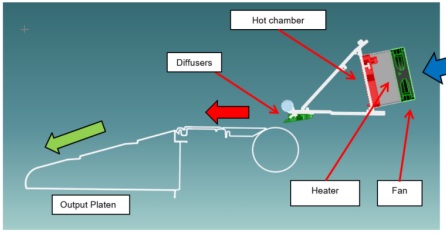In the digital giant format textile business, the drying system is one amongst the most vital subsystems within the printer. The objectives of this method are dry the media enough in order that there’s no transfer between the rolled media and also the following one, and to produce a hot air (airflow and temperature) within the print zone to reduce bleed and coalescence. And one amongst the most critical parameters within the dryers is that the management of the temperature uniformity on the scan axis within the print zone. A fine control of the temperature uniformity will increase the media versatility by enabling lower temperatures within the print zone whereas drying and increase the throughout capability level. Also improves bleed and coalescence and alternative image quality artifacts. In many printers, the drying system is based on convection with a hot chamber flowing hot air through several diffusers to the print zone.
In those drying systems, in most of the cases, the temperature uniformity can be achieved by separating the chamber in several modules. Each module controlled independently.
The main drawback resolved by this invention is that the improvement of the temperature uniformity in each the hot chamber and therefore the print zone on the scan axis. Within the dryer convection systems (that are using many local fan/heaters assemblies on the chamber) it’s difficult to confirm the uniform temperature and pressure. but if the variability of the temperature may be controlled and reduced then the temperature may be reduced (allowing wider media ranges) or the drying capability may be improved.
Prior solutions and their disadvantages to improve the temperature uniformity in the convective dryers, in the hot chambers, are:
Use a unique hot chamber along the scan axis:
There is a unique chamber and many fan/heaters assemblies on the scan axis and the temperature sensors may be implemented or not.
These are the main disadvantages of this configuration:
- Large variability of temperature along the hot chamber and the print zone
- When there is no temperature sensor in the chamber, the air temperature cannot be controlled. In some printers, the heater is only used to warm‐up the printer when the external temperatures are low.
Use several hot multi‐chambers along the scan axis:
There are several chambers (depending on the printer width) with a fan/heater/temperature sensor in each chamber. Each module can control de air temperature with temperature sensor. The main disadvantage of this configuration is the cost implied and the overall complexity. Each module required each hardware supports and PCA controls.
Increase the number of fans/heaters in a unique chamber along the scan axis:
Another option can be used to improve the temperature uniformity can be increase the numbers of fans/heaters assemblies along the scan axis. The more fan/heaters assemblies, better temperature uniformity can be got.
The main disadvantage of this configuration is the cost of the components
- Fan
- Heater
- Temperature sensors
Advantages of the solution over what has been done before:
- As stated before, this solution offers much better temperature uniformity along the scan axis hot chamber and reducing the cost and the complexity of the drying system.
- Another important advantage is that, since the temperature sensor is not located in the hot airflow, the measurement variability is much accurate.
- And another important advantage of the solution is that the whole assembly (fan + heater + air distributor + temperature sensor) serviceability is very good. All the components of the Drying System can be replaced very easily by service or even trained customers.
We at KERONE have a team of experts to help you with your need for Drying Systems in various products range from our wide experience.

